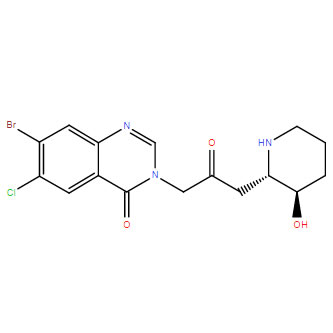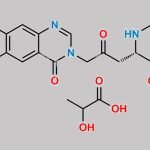Halofuginone CAS#: 55837-20-2; ChemWhat Code: 1369431
Identification
| Product Name | Halofuginone |
| IUPAC Name | 7-bromo-6-chloro-3-[3-[(2S,3R)-3-hydroxypiperidin-2-yl]-2-oxopropyl]quinazolin-4-one |
| Molecular Structure |  |
| CAS Registry Number | 55837-20-2 |
| Synonyms | 7-bromo-6-chlorofebrifugine; halofuginone; halofunginone; Stenorol; 7-bromo-6-chloro-3-[3-[(2S,3R)-3-hydroxypiperidin-2-yl]-2-oxopropyl]quinazolin-4-one; Tempostatin; RU 19110 |
| Molecular Formula | C16H17BrClN3O3 |
| Molecular Weight | 414.686 |
| InChI | InChI=1S/C16H17BrClN3O3/c17-11-6-13-10(5-12(11)18)16(24)21(8-20-13)7-9(22)4-14-15(23)2-1-3-19-14/h5-6,8,14-15,19,23H,1-4,7H2/t14-,15+/m0/s1 |
| InChI Key | LVASCWIMLIKXLA-LSDHHAIUSA-N |
| Canonical SMILES | C1CC(C(NC1)CC(=O)CN2C=NC3=CC(=C(C=C3C2=O)Cl)Br)O |
| Isomeric SMILES | C1C[C@H]([C@@H](NC1)CC(=O)CN2C=NC3=CC(=C(C=C3C2=O)Cl)Br)O |
| Patent Information | ||
| Patent ID | Title | Publication Date |
| WO2007/120606 | METHODS FOR MODULATING FORMATION AND PROGRESSION OF CELLULITE | 2007 |
| EP1109559 | INHIBITION OF PATHOGENIC PROCESSES RELATED TO TISSUE TRAUMA | 2005 |
| US4665100 | Process for formulating a synthetic drug for use in animal feed, and resulting formulation | 1987 |
Physical Data
| Appearance | White or off-white powder |
| Solubility | DMSO : 9 mg/mL (21.70 mM; Need ultrasonic and warming) |
| Boiling Point | 595.8 °C at 760 mmHg |
| Density | 1.73 g/cm3 |
| Melting Point, °C |
| 144 – 147 |
| 160 |
Spectra
| Description (NMR Spectroscopy) | Nucleus (NMR Spectroscopy) | Solvents (NMR Spectroscopy) | Frequency (NMR Spectroscopy), MHz |
| Chemical shifts | 1H | dimethylsulfoxide-d6 | 500 |
| Chemical shifts | 13C | dimethylsulfoxide-d6 | 125 |
| Chemical shifts | 13C | chloroform-d1 | 125 |
| Chemical shifts | 1H | chloroform-d1 | 500 |
| Description (IR Spectroscopy) | Solvent (IR Spectroscopy) |
| Bands | neat (no solvent, solid phase) |
Route of Synthesis (ROS)

| Conditions | Yield |
| With potassium carbonate In water pH=10 Experimental Procedure The salt (-)-32HBr was basified topH 10 with 0.1Maq. K2CO3 and extracted with DCM (5 5 mL). Thecombined organic layers were washed with brine (25 mL), driedover MgSO4, filtered, and concentrated in vacuo (without heating) to afford (-)-3 (14 mg, 93percent) as a white solid. Mp 143e145 C;{lit.,9 Mp 160 C (decomp.)}; [a]D20 5.4 (c 0.50, EtOH); {lit.,9[a]D2010 (c 0.5, DMF)}; IR (neat): 3128, 2926, 2852, 1722, 1674,1607, 1448, 1382, 1309, 1223, 1106, 1075, 1043, 900 cm1; HRMS(ESI): calcd. for [C16H1779Br35ClN3O3 H] 414.0220, found 414.0212;1H NMR ((CD3)2SO, 500 MHz): d 1.16e1.42 (m, 2H), 1.52e1.61 (m,1H), 1.84e1.95 (m, 1H), 2.32e2.40 (m, 1H), 2.45 (dd, J 15.5, 9.0 Hz,1H), 2.64 (td, J 9.0, 4.0 Hz, 1H), 2.75e2.84 (m, 1H), 2.93e3.03 (m,2H), 4.76 (d, J 6.0 Hz, 1H), 4.94e5.06 (m, 2H), 8.16 (s, 1H), 8.22 (s,1H), 8.24 (s, 1H) ppm (OH not visible by 1H NMR spectroscopy); 13CNMR ((CD3)2SO, 125 MHz): d 26.3 (CH2), 34.7 (CH2), 44.1 (CH2), 46.0(CH2), 55.3 (CH2), 60.5 (CH), 71.2 (CH), 122.2 (C), 127.4 (CH), 128.8(C), 132.2 (C), 132.8 (CH), 147.8 (C), 150.2 (CH), 159.1 (C), 203.9 (C)ppm. | 93% |
Safety and Hazards
| Pictogram(s) |      |
| Signal | Danger |
| GHS Hazard Statements | H300: Fatal if swallowed [Danger Acute toxicity, oral] H301: Toxic if swallowed [Danger Acute toxicity, oral] H310: Fatal in contact with skin [Danger Acute toxicity, dermal] H315: Causes skin irritation [Warning Skin corrosion/irritation] H317: May cause an allergic skin reaction [Warning Sensitization, Skin] H318: Causes serious eye damage [Danger Serious eye damage/eye irritation] H330: Fatal if inhaled [Danger Acute toxicity, inhalation] H361: Suspected of damaging fertility or the unborn child [Warning Reproductive toxicity] H372: Causes damage to organs through prolonged or repeated exposure [Danger Specific target organ toxicity, repeated exposure] H400: Very toxic to aquatic life [Warning Hazardous to the aquatic environment, acute hazard] H410: Very toxic to aquatic life with long lasting effects [Warning Hazardous to the aquatic environment, long-term hazard] Information may vary between notifications depending on impurities, additives, and other factors. |
| Precautionary Statement Codes | P201, P202, P260, P261, P262, P264, P270, P271, P272, P273, P280, P281, P284, P301+P310, P302+P350, P302+P352, P304+P340, P305+P351+P338, P308+P313, P310, P314, P320, P321, P322, P330, P332+P313, P333+P313, P361, P362, P363, P391, P403+P233, P405, and P501 (The corresponding statement to each P-code can be found at the GHS Classification page.) For more detailed information, please visit ECHA C&L website |
Other Data
| Transportation | Not dangerous goods |
| Under the room temperature and away from light | |
| HS Code | 294200 |
| Storage | Keep container tightly sealed in cool, well-ventilated area. Keep away from direct sunlight and sources of ignition. Recommended storage temperature: -20°C 3 years 4°C 2 years |
| Shelf Life | 1 year |
| Market Price | USD 2300/kg |
| Use Pattern |
| Halofuginone CAS#: 55837-20-2 is usually used as a pharmaceutical |
| angioplasty |
| atherectomy |
| atherosclerosis |
| bypass surgical procedure |
| drug-eluting stent |
| Halofuginone CAS#: 55837-20-2 is a less-toxic form of Febrifugine, which is isolated from the plant Dichroa febrifuga. Halofuginone inhibits prolyl-tRNA synthetase in an ATP-dependent manner with a Ki of 18.3 nM. Halofuginone attenuates osteoarthritis (OA) by inhibition of TGF-β activity. |
Related Chemicals
Buy Reagent | |
| No reagent supplier? | Send quick inquiry to ChemWhat |
| Want to be listed here as a reagent supplier? (Paid service) | Click here to contact ChemWhat |
Approved Manufacturers | |
| Caming Pharmaceutical Ltd | https://www.caming.com/ |
| Want to be listed as an approved manufacturer (Requires approvement)? | Please download and fill out this form and send back to approved-manufacturers@chemwhat.com |
Contact Us for Other Help | |
| Contact us for other information or services | Click here to contact ChemWhat |




